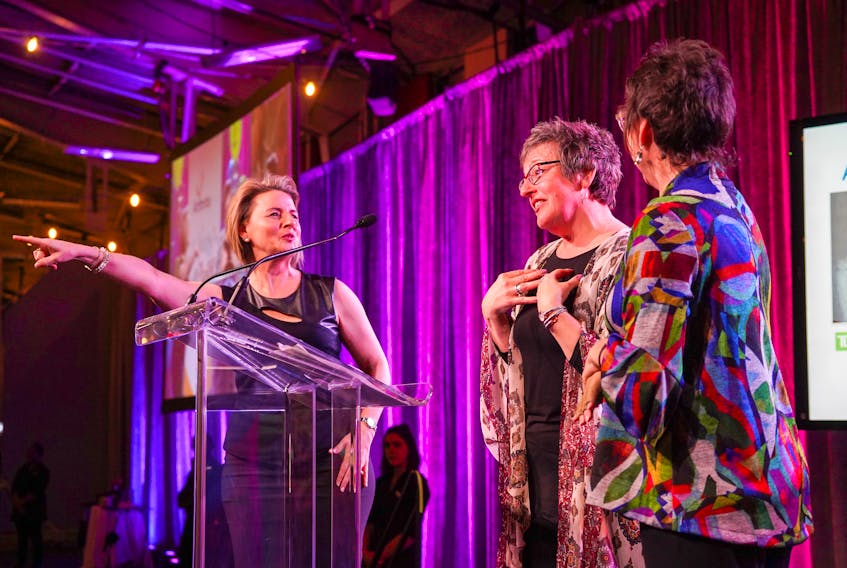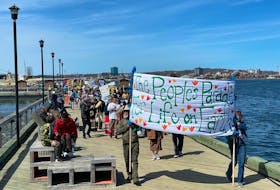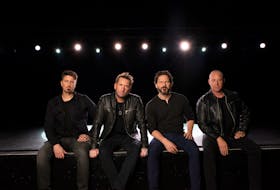PORT WILLIAMS, N.S. — Nicole Veinotte is bilingual, but her second language is not what most people would guess.
It only takes a moment with Veinotte to see how expressive she is, how she instinctively talks with her hands.
For the past 22 years, the Port Williams resident has been working as an American Sign Language (ASL) interpreter.
Veinotte’s interest in ASL stemmed from having grown up in Cape Breton with six other siblings. Her sister, Kelly, started attending the School for the Deaf in Amherst at eight years old, making it hard for them to spend time together in their younger years.
“I remember deaf adults coming and staying at my house for meetings and deaf social events in Cape Breton,” says Veinotte. “I also remember traveling from Cape Breton to Amherst most weekends in the station wagon to stay at the Wandlyn Inn and have a visit with my sister.”
At the age of four, Veinotte joined the rest of her family in taking a Level 1 sign language course to learn to better communicate with Kelly. She says each family member communicated with Kelly in different ways, including gestures or a makeshift sign language between sisters.
“Kelly was very patient with us all, but I am sure it was so frustrating to come home for summers and not be able to use her own natural language with her family,” says Veinotte.
Once she went to university and started to mature, Veinotte says she reflected on her family dynamics and felt compelled to make it a priority to learn about Kelly’s culture and the world of the deaf community. She wanted to ensure that when together, the family was bilingual.
NO LONGER COMPLACENT
During university, Veinotte took a summer job at the Society of Deaf and Hard of Hearing Nova Scotians in Halifax that she says woke her up from being complacent about her lack of communication with her sister.
“I was around a lot of hearing and deaf people working together and understanding each other fully,’ she says. “I wanted that for me and my sister.”
So, she decided to learn the language.
After finishing her psychology degree at Dalhousie University, Veinotte thought about pursuing a career in counselling but then took an NSCC pilot interpreter training program in Halifax. At the time, another older sister had been interpreting in Ontario and seemed to have such an interesting and successful career. If nothing else, Veinotte thought she could become a counsellor that worked with deaf clients.
She quickly realized she was not quite as fluent in sign language as she thought, and she would later work hard for many years before feeling confident in ASL.
Soon after, Veinotte began her career with the Atlantic Provinces Special Education Authority and was hired as the first interpreter at Wolfville school to interpret with Deaf and Hard of Hearing students in various mainstreamed classrooms.
“Many of the students had not seen or worked with an interpreter before, so we were all in learning mode together that first school year,” says Veinotte, who found the job to be a lot of work, but very rewarding.
From there, she worked for post-secondary institutions, interpreting with professors for young adults. Before going into classes, Veinotte had to do preparatory learning as she couldn’t put something into a different language that she didn’t understand in her first.
A BUSINESS IS BORN
About eight years ago, Veinotte switched gears again, and after having passed a special screen test with the Translation Bureau at the federal government level, she now interprets for government employees, and has started her own interpretation business, setting her own working schedule.
She travels the Maritimes on a variety of assignments in a variety of settings, including legal, medical, mental health, employment training and meetings, dental, and physical therapy. When not on the road, she works on a part-time basis with an American company based in Halifax Metro, where she is hired to provide video relay interpreting services.
“I love providing interpreting services in hospitals and doctor appointments,” says Veinotte. “It is great to have such important information and testing in someone’s preferred language choice, obviously, but it is also very challenging.”
With all the online resources, Veinotte says she has access to so much medical information and pictures to help her prepare for tests and procedures that her clients will go through. But nothing can prepare her for unexpected medical news or for medical staff that don’t feel comfortable with having an interpreter in the room at times, she says.
Because of the nature of her job, Veinotte says she has to practice self-care in order to get through some of these difficult moments.
“I work by a professional code of ethics by my national governing interpreting association, so I don’t and can’t share details of my daily assignments with anyone,” she says, adding that it makes it difficult at times.
On the more positive side, Veinotte says she has been part of many joyous family occasions like weddings, child births, elementary school concerts, religious events and graduations. Each one of those events holds a dear spot in her heart and memory.
EQUALITY FOR ALL
Regardless of the situation, Veinotte says she always feels successful when she interprets a course, or a job interview and the student or employee feels satisfied with their experience. She also feels a sense of accomplishment when a hearing person truly gets that the only difference between a Deaf or hearing person is their ability to hear.
Veinotte says there is always a need for ASL interpreters. There has been a core ASL/English Interpretation Program at NSCC now for about 20 years, which graduates less than 10 interpreters bi-annually, however, not all the graduates stay in Nova Scotia. Canada has just established their own video relay interpreting company across the country, too, so, there is greater need to fill the video interpreter jobs along with interpreters that work in the Deaf community like Veinotte does.
“I don’t feel like technology and innovations can replace the authenticity and connections that real live interpreters can provide,” she says.
Anyone interested in learning some sign language can start by learning the basics. Things like ‘Thank you’, ‘please’, ‘sorry’, ‘yes’, ‘no’ can go a long way, and there are many online videos dedicated to learning ASL, she says.
After learning some basic signs online, Veinotte says it’s time to practice. Search for events or organizations that can help.
Veinotte says she longs for the day that all humans, regardless of the senses they have or lack, are truly treated as equals.
“This is why I love bridging the gap between the hearing and the Deaf world. I see myself as a conduit of communication between the two.”
DID YOU KNOW?
Sign language is not universal. Sign language interpreter Nicole Veinottes says there is somewhere between 138 and 300 different types of sign language. American Sign Language (ASL) is different from BSL (British Sign Language) or LSQ (Langue des Signes du Quebec - Quebec Sign Language).
There are also regional differences in signs depending on where you live, even in Canada. Here, we have Maritime Sign Language, explains Veinotte. Atlantic Canada had a British influence when they first established education specific for members of the deaf and hard of hearing community, which the rest of Canada didn’t have, so that is where you see subtle differences in the language and grammar.
So, for example, when Veinotte is working in the video relay interpreting center and working with American users, she has to learn, remember and use their signs.
“Sometimes a fellow Canadian, living in the United States will catch me signing the Canadian version and immediately ask me if I am a Canadian,” she says.
She says the semantics and syntax of ASL is complicated and takes a long time to master, which means she’s constantly learning even after 22 years of working with ASL.








